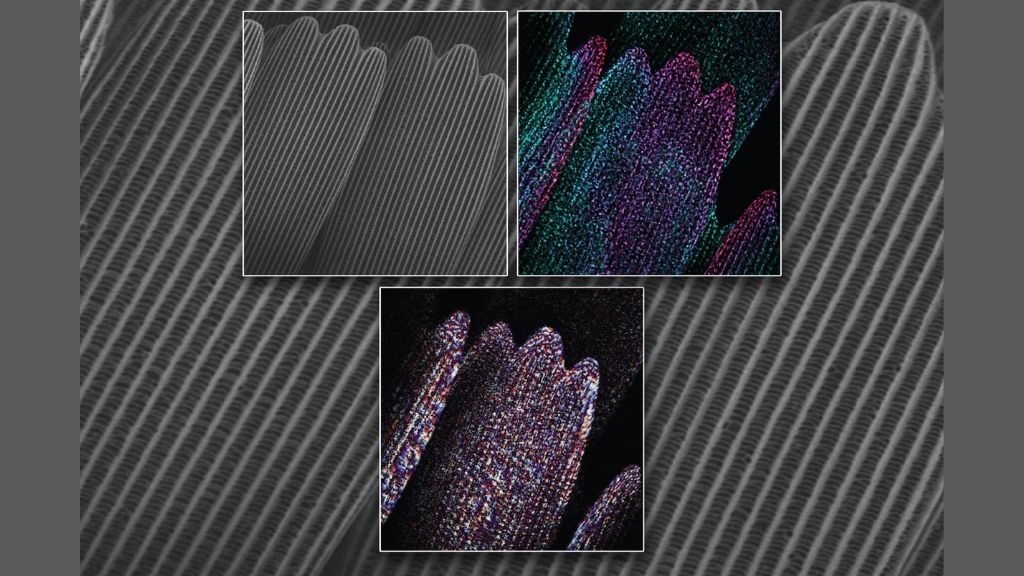New video reveals how 'caterpillar soup' transforms into shimmering butterfly wings
New videos show how the delicate scales of butterfly wings form.

To transform into a butterfly, a caterpillar must first dissolve into a goopy soup within its chrysalis. Now, in striking new videos, scientists have revealed how this goo reassembles into the delicate scales on a butterfly's wings.
To watch this process unfold in living caterpillars undergoing metamorphosis, the researchers behind the videos reared painted lady caterpillars (Vanessa cardui) in their laboratory, according to the new study, soon to be published in the journal Proceedings of the National Academy of Sciences (PNAS). Once each caterpillar was suspended in its chrysalis, the team carefully carved a small window into the cuticle — the pupae's hard, outermost covering — to expose the developing forewings within. They then sealed these tiny openings with thin panes of glass held in place with a dental composite. The team used a slightly modified version of this technique to uncover the developing butterflies' hindwings.
Thus exposed, the developing wings could be observed under a microscope as the soup-ified caterpillars continued their metamorphosis, unmarred by the surgical procedure. However, conventional microscopes that use a single, wide beam of light to illuminate their subject could potentially damage the dainty scales. So instead, the team opted to use speckle-correlation reflection phase microscopy, which uses many tiny pinpricks of light to illuminate a subject, according to a statement about the study.
Related: In photos: Jaw-dropping images reveal science is amazing

The lights bounced off of different points on the butterfly wings, and the team then constructed detailed maps of the wings' structure by analyzing exactly how and where these points of light reflected. "Using this method, we can isolate the light coming from different layers, and can reconstruct the information to map efficiently a structure in 3D," Peter So, a professor of mechanical engineering and biological engineering at the Massachusetts Institute of Technology (MIT), said in the statement.
A few days after the start of metamorphosis, the team watched individual cells line up in orderly rows in the butterfly wings; each cell gave rise to a single wing scale by secreting chitin, a type of sugar, the team wrote in the study. As these scales formed, they fell into an alternating pattern of cover scales — which sit on top of the wing — and ground scales — which lie beneath the cover.
Long, thin ridges then appeared on the surface of the scales, running down their lengths in tidy, parallel lines. A painted lady's entire pupal stage typically lasts about 8 to 12 days, and these ridges appeared about 60% of the way through the process, the authors wrote in their report.
Sign up for the Live Science daily newsletter now
Get the world’s most fascinating discoveries delivered straight to your inbox.
"A lot of these stages [of metamorphosis] were understood and seen before, but now we can stitch them all together and watch continuously what’s happening, which gives us more information on the detail of how scales form," lead author Anthony McDougal, a research assistant in MIT’s Department of Mechanical Engineering, said in the statement.
Prior to the new study, researchers had captured snapshots of select stages of this process, but now, we can watch the entire transformation play out like a movie.
Originally published on Live Science.

Nicoletta Lanese is the health channel editor at Live Science and was previously a news editor and staff writer at the site. She holds a graduate certificate in science communication from UC Santa Cruz and degrees in neuroscience and dance from the University of Florida. Her work has appeared in The Scientist, Science News, the Mercury News, Mongabay and Stanford Medicine Magazine, among other outlets. Based in NYC, she also remains heavily involved in dance and performs in local choreographers' work.










